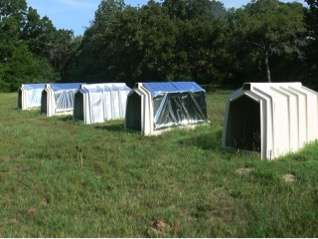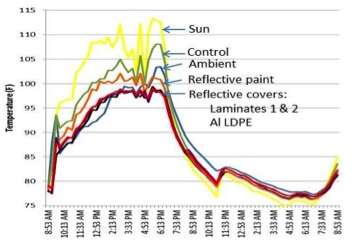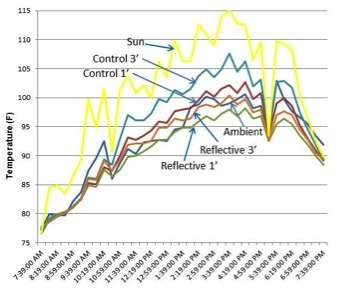Research focuses on reducing heat stress for calves in plastic hutches

A recent series of studies found reflective covers to be beneficial for dairy calves housed in calf hutches.
Dr. Ted Friend, a retired Texas A&M AgriLife Research scientist and professor in the department of animal science a Texas A&M University in College Station, has studied several reflective films for use in covering calf hutches to reduce heat stress on calves and determined that an inexpensive film is "very effective in improving comfort and health."
"The only shade available to calves in plastic hutches is from the hutch, and the quality of that shade can be easily improved to help calves cope with hot conditions," Friend said. "Also, animal welfare auditors are paying more attention to the quality of shade during hot conditions. Simply placing calf hutches under shade structures creates another set of challenges when the usefulness of direct sunlight for drying bedding and killing pathogens is lost."
Calf hutches are used for effectively improving health and growth prior to weaning. Friend's hutch study measured air temperature and radiant heat, using black ping-pong balls used in old-style flush toilets during the 1970s. A hole was drilled through the black ball and the bulb of a thermometer was inserted. The study also evaluated reflectivity materials, which affect the temperature reading on the black globes.

"A simple solution to keep something from heating up in the sun is to make it more reflective so it absorbs less radiation," he said. "Aluminum is the most cost effective reflective material available, and it's the reflective surface in most of the mirrors we have in our houses. One type of reflective material or film is laminates, which involve a thin layer of aluminum foil sandwiches between one or more protective layers and base layers."
The first set of trials determined if there were meaningful differences between some reflective materials. An uncovered control hutch was compared to hutches with two types of laminate covers: aluminized white low density polyethylene aluminized low-density polyethylene or Al LDPE cover and a reflective paint. Two 24–hour long trials were conducted approximately one week apart on relatively hot and calm days in College Station.
Although the goal was to pick days with no clouds, being located only about 140 miles north of the Gulf of Mexico, the southern summer winds create almost tropical conditions with afternoon clouds, Friend said.
"The heat and humidity were the major reason most dairy farms left this area of Texas 40 years ago," he said.
The location of the treatments within the row of hutches was rotated between trials to help control for location effects. A calibrated iButton temperature logger programed to record temperatures at 20-minute intervals was inserted into each of two black globes that were located in full sun. A second set of two black globes were mounted 1 foot above the ground in the center of the interior of each hutch.
"The distance of one foot is about the elevation of the head of a calf when lying in a hutch," Friend said.
Ambient, or shade, temperature was also recorded using two loggers placed in shade, and the readings from all of the sets of loggers were averaged to improve accuracy.

Despite the fluctuation in solar radiation, the ambient temperature steadily climbed through the afternoon, Friend said. The three hutches with covers had a very similar pattern. During the hottest two-hour period for both trials, the uncovered and painted hutches were significantly warmer than the three hutches with reflective covers.
"Although the laminated covers were very similar to the Al LDPE cover, the Al LDPE cover is about tenfold less expensive, so we shifted to focusing onto the inexpensive material, developing mounting systems and testing its longevity," Friend said.
To determine the effect of distance from the ceiling, a trial was conducted with black globes mounted 3 feet and 1 foot above the ground in selected hutches. Three feet was chosen because it is about the height where the back and head of a standing calf would be. Black globe temperature was much higher at 3 feet than at 1 foot.
"For example, at 3:39 p.m. when the hottest temperatures were recorded, the black globe at 3 feet was 5.6 degrees hotter than the black globe at 1 foot," Friend said. "During hot conditions, adult dairy cattle stand to help increase heat loss, but calves in hutches are exposed to much more radiant heat if they stand in hutches on hot sunny days. It is a mistake to assume that because calves are lying in hutches during the heat of the day, the calves are comfortable."
Friend added that reflective covers certainly improve the comfort of calves in hutches, but are conditions improved enough that changes important to improving health and productivity in the calves.
"The first thing people ask about is whether weight gain is improved," he said. "Statistically significant changes in weight in calves consuming milk is difficult to achieve unless you can accurately weigh large numbers of animals because the calves consume all of their diet unless they are extremely sick. However, we do see very convincing trends when our cooperating farms have hot conditions during the summer."
In one experiment, Friend said they used 12 to 24 covers on three farms in the Texas Panhandle. Improvement in weight gain ranged from 0.39 pounds per day /day, 3.1 pounds over 80 days to 0.99 pounds per day or 7.93 pound over 80 days.
"One of our biggest problems is that many farms weigh their calves in groups by loading them on a trailer and driving the load over their commodity scales," he said. "Although there may be 24 calves on the trailer, that single weight cannot be statistically analyzed."
In 2013, Friend said his group conducted additional trials in the Texas Panhandle and Arizona. The Panhandle had an exceptionally cool summer so that study was not useful, but it was hot in Arizona.
"Even though the farm in Arizona used cinder blocks to raise the backs of their hutches to maximize ventilation, the Al LDPE covers resulted in the internal air temperature being 3.9°F cooler, calf panting was much lower during hot periods of the day, and there were trends toward calves needing less medical treatments and gaining more weight 7.5 pounds over 65 days." period. close quotes
"We also saw similar reduction in panting when we measured respiration rates in a study several years earlier when there was a hot summer in the Panhandle.
"In conclusions, we used both Calf-Tel and Agri-Plastics brand hutches in our studies and we have seen little difference between them," Friend said. "Elevating the backs of hutches does increase ventilation, but that has little influence on radiation coming from the hot surfaces of the hutches. Reflective coatings and paints can help a little, but the paint will also be on the hutch during moderate and cold conditions, which could be counterproductive."
Some commercial coatings also cost $40 or more per hutch and that does not include labor, he said.
"For all practical purposes, the Al LDPE is as effective as laminate material that can cost 10 times as much, and the AI LDPE performs better under farm conditions," Friend said. "The fabrication of the covers and the mounting system has steadily improved over recent years and will be available for purchase this spring as Cool-Calf Covers."
Provided by Texas A&M University

















